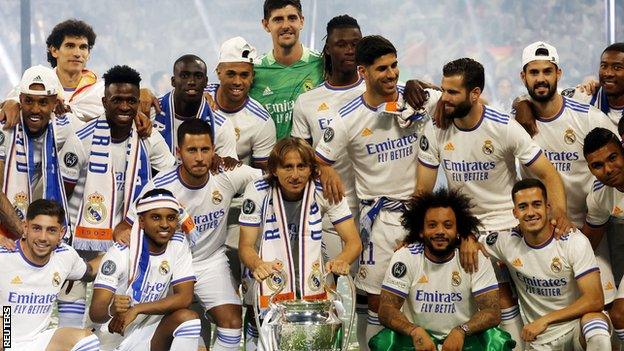Deloitte report: European football has made 'significant recovery' after Covid pandemic
- Published

The international broadcast rights for Spain's La Liga are worth roughly £760m
The European football market made "a significant recovery" in 2020-21 despite fans being absent for most of the season, says finance company Deloitte.
In 2019-20, the coronavirus pandemic saw European leagues' revenue decrease for the first time since 2008-09.
But deferred broadcast revenues and the success of Euro 2020, delayed to the summer of 2021, were the main factors in the turnaround.
Revenue for the 'big five' European leagues (England, Spain, Italy, Germany, France) is now projected to surpass pre-pandemic levels in 2021-22.
Deloitte's Tim Bridge, speaking about his company's 'Annual Review of Football Finance' said leagues and clubs had worked hard to seek external investment following the pandemic with a "shift in trends around transfer spending and club operations".
However, he now predicts "an exciting period" that will "challenge clubs to break from tradition".
"It's testament to the resilience of the industry, the value driven by broadcast deals and the success of the Euros that the European football market has achieved tenacious growth, in revenue terms, over the past year," said Bridge.
Key findings from Deloitte's annual review of football finance
The European football market grew combined revenue to £24.4bn in 2020-21 - up by 10% on the previous year
The Premier League clubs' revenues rose to £4.9bn - up 8%
The 'big five' European leagues generated £13.8bn euros in revenue - up 3%
The Premier League was the only one of the 'big five' to see clubs improve total operating profits - from £49m to £479m
The 'big five' excluding the Premier League reported increased total operating losses - from £408m to £797m
Premier League clubs' net debt at the end of 2020/21 was £4.1bn - up 4%
Championship clubs' net debt was £1.8bn - up 32%
General
The 'big five' European leagues represent a 57% share of the European football market, but revenue polarisation between and within European leagues continues to grow.
In 2019-20, the Premier League, Serie A, La Liga seasons and Uefa club competitions were completed during the 2020-21 financial year, so a portion of broadcast revenue related to 2019-20 is actually recognised in 2020-21.
Deferred broadcast revenue is the main reason for the Premier League's growth in 2020-21, while Serie A's revenue increased by 23% to a record high of £2.2bn.
Revenue in La Liga and the Bundesliga fell slightly while Ligue 1's grew by just 1%.
The Premier League is further ahead of the competition than ever before and is expected to extend its revenue advantage.
It generated almost double that of the Bundesliga (£2.7bn) in 2020-21, with La Liga and Serie A narrowly further back.
With fans being back and a new Uefa broadcasting cycle from 2021-22 to 2023-24, the 2022-23 season is forecast to see the 'big five' generate a record of £16.4bn aggregate revenue.
Premier League
Premier League clubs' wage costs increased 5% to £3.5bn in 2020-21, with only seven of the 17 consistent Premier League clubs reporting a reduction.
While operating profits increased, only four clubs reported a pre-tax profit and pre-tax losses remained significant despite decreasing from £991m to £669m.
Also, 78% of the Premier League's aggregate commercial revenue was generated by its 'big six' clubs.
The average revenue per club was £243m, with the sixth highest - Arsenal (£325m) - well clear of the seventh highest - Leicester City (£226m).
While the revenue gap between the 'big six' and the rest decreased by £56m, it is expected to grow as matchday revenue increases and the 'big six' benefit from the new Uefa broadcast cycle.
Bridge said that the Premier League "emerged from the pandemic without as significant an increase in net debt as many might have expected" but stressed the need for "strong governance and financial planning in the years ahead".
English Football League
The competitive advantage of clubs with parachute payments has had an impact in the Championship, along with the cycle of clubs gambling on promotion.
Combined revenue decreased by 12% to £600m, largely due to matchday revenue falling by £101m, and although Championship clubs managed to reduce wage costs by 8% to £747m, they exceeded revenue for the fourth consecutive year - with a record high wages/revenue ratio of 125%.
In League One, club revenues fell by 22% to £129m and the average wage costs of £5.5m surpassed revenue for the first time with a wages/revenue ratio of 103%.
As for League Two, club revenues fell by 4% to £94m and the wage cost was £3.1m, with a ratio of 80%.
"There now can be no doubt that significant change is required to drive long-term financial sustainability in the Championship," added Bridge.
Women's game
Deloitte was unable to perform the same kind of audit on the women's game as the men's.
But, after a record-breaking year, with more tickets being sold across Euro 2022 than any other European Women's Championship (500,000) and a record 17.4m viewers tuning into the BBC's coverage of the Euros final, between England and Germany, Deloitte says they will continue to report on the progress of the women's game.
Commercial was the largest revenue stream for women's clubs - bringing in over 50% of total revenue - with clubs reporting an increase of 30% overall in 2020-21, the strongest period of growth.
Broadcast revenue grew by over 20% with the Women's Super League securing a £8m rights deal with BBC and Sky Sports, increasing viewership by 285% in its first year.
Uefa says that women's football in Europe could have a commercial value of £578m a year by 2033 with the fanbase for the game potentially rising from 144 million to 328 million across that period.

Our coverage of your Premier League club is bigger and better than ever before - follow your team and sign up for notifications in the BBC Sport app to make sure you never miss a moment
